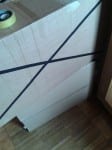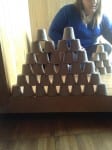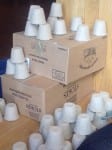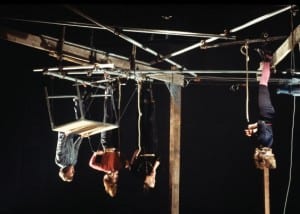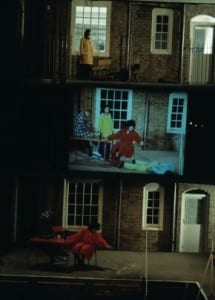One week we showed part of our performance to an audience in our space and received constructive criticism and feedback for us to progress on over the next few weeks.
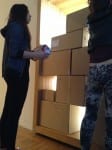
The audience questioned our decisions on the cardboard boxes and our choice of using pens to write with, and asked how our choices aided our motives. They were unsure about the black marker pens to write our statements on, and how the choices of phrases were too obvious for the audience. We therefore explored the details of our cardboard boxes to cover up our desired space and came to a decision on the visual elements. By discussing the factors of colour, size and uniformity, we agreed on a monotonous touch of keeping the boxes as they are, brown and shabby. This would hopefully portray to the audience our intention of showing how tedious and dull the routine of life is.
Another aspect they touched on were little but important things such as our background music, the poem we wrote; it was too quietly said and didn’t have the effect it deserves and how we would incorporate the twin space on the other side of The Collection. Whilst crucial to our overall performance, we focused first on our boxes and finding what appropriate ways to show our performances intention, while relating back to our space.
Allan Kaprow states that; ‘there doesn’t need to be a distinction between life and Art, life can be Art’. This to me coincides with our exposure of the space and how we can make our small space a piece of art work in itself. Art and the environment therefore represent the subtleness of everyday life, and our performance will question the monotony of life and how we can connect the concept into our space. Our visual inspiration had come originally from focusing on the spaces that went amiss by an audience or even the general staff that work in The Collection, and how we can see something, but won’t really take note or consideration of it. This is how we felt about our side space that has no artistic statement at all. In our performance, due to the fact that our space is overlooked we instantly felt the need to fill the space and see if anyone would realise. This idea also tied in well with our theory, as in the gallery the art work consists of old boxes with numbers and writing on. This allowed us to challenge the audience into interpreting our boxes as the contemporary art itself or our dramatic statement.
In preparation for our performance we discussed what we would write on our boxes, as this is a crucial element to our performance. We looked at symbolic words or phrases that could possibly sum up our performance. We spent some time in the library progressing on our interest to the monotony of life and how we could integrate the concept into our space; brainstorming words that coincide with the small space and our interest in the art already in the space. Words such as; controlled, suffocated and restricted allow the audience to delve into the confined atmosphere that is our performance whilst following us around the museum, which contrasts completely with the cramped feel of our spaces.
Being an enclosed space we liked the idea of claustrophobia and the light trying to get through the boxes from behind. Due to the long deliberation of interpreting our words into symbols, we then came to a result of roman numerals. We felt that they emphasised the dullness and routine feel of life and the robotic, monotonous mood we were creating.
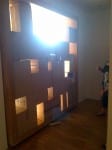
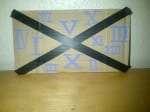
On a lighter note, we incorporated the use of 4 balloons to literally show the exposure of not only the space but what we can do in the space. It was also aesthetically pleasing as a contrast to the dull brown boxes. This is important to us as we had chosen an area in the Collection that we felt connected artistically and symbolically to our performance. In order to keep the boxes together and uniformed we decided to use tape and black tape instead of a staple gun to hold the boxes, due to the health and safety and the noise a staple gun would make. The ‘X’ across allowed us to show the rusty, old boxes yet kept a certain consistency to our image.
